
From Dams to Green Infrastructure:
Managing rivers for the 21st century
John Seebach
Director of American Rivers' Hydropower Reform Initiative

I would like to begin today by thanking everyone here for the work that
you are doing. I have fond memories of the many weekends that I spent kayaking
on whitewater rivers like the Yoshino River and the Nagara River when I
was a lived in Japan during the late 1990s. Having moved here from the
mountains of Western North Carolina, where quite a few of our rivers still
flow free, I was shocked by how many of Japan's rivers were dammed, channelized,
diverted, or otherwise covered in concrete. One of my close friends, a
science teacher at the high school where I worked, taught me about the
Nagara Tidal Barrage and other environmental justice issues in Japan. I
recall following closely the news of the public referendum in Tokushima
on the proposed Dam on the Yoshino River, and was deeply moved and impressed
by the sight of ordinary citizens triumphing over a powerful, cynical bureaucracy.
In fact, it inspired me to do the river conservation work that I do now.
This is an exciting time for me to be back in Japan and talking about environmental issues, especially dam issues. I feel that you all have a great opportunity before you to shift the status quo between public works projects that seem to pour concrete over every available surface and projects that work for the public by restoring the natural environment and the valuable services that rivers, forests, and wetlands provide. There is great beauty in nature, but there is also great function, and your challenge now is to find the best ways to restore and preserve those natural functions.
 We have made great strides in the United States in undoing some of the
massive environmental damage associated with dam construction. Starting
in the 1950s and 1960s, environmental groups were able to stop many large
dams from being built, effectively halting the era of dam construction
in the U.S. In the 1970s, we passed a law that provided permanent protection
for Wild and Scenic Rivers, keeping them forever free from dams. Starting
in the late 1980s, we developed ways to force hydropower dam owners to
build fish passage and make other operational changes that have improved
conditions on rivers affected by hydropower dams. And in the 1990s, we
started to remove obsolete, harmful dams, changing dam removal from a radical
idea to a cost-effective, sensible way to protect public safety and restore
the environment.
We have made great strides in the United States in undoing some of the
massive environmental damage associated with dam construction. Starting
in the 1950s and 1960s, environmental groups were able to stop many large
dams from being built, effectively halting the era of dam construction
in the U.S. In the 1970s, we passed a law that provided permanent protection
for Wild and Scenic Rivers, keeping them forever free from dams. Starting
in the late 1980s, we developed ways to force hydropower dam owners to
build fish passage and make other operational changes that have improved
conditions on rivers affected by hydropower dams. And in the 1990s, we
started to remove obsolete, harmful dams, changing dam removal from a radical
idea to a cost-effective, sensible way to protect public safety and restore
the environment.
I would like to talk to you today about some of the strategies that we have used to accomplish those goals. I hope that you may find some useful ideas that you can apply to your efforts here in Japan.

First, I would like to briefly discuss the history of dam building in my
country. The United States' rivers have been extensively dammed, although
the exact number of dams is unknown. The U.S. Army Corps of Engineers'
National Inventory of Dams, which only counts larger dams, includes more
than 85,000 dams. The average age of these dams is 51 years old, and more
than 4,000 of these dams are considered by the Association of Dam Safety
Officials to be deficient or unsafe, a number that is unfortunately growing.
More than 1,800 of these deficient or unsafe dams are classified as "high
hazard," meaning that they pose a significant threat to public safety.
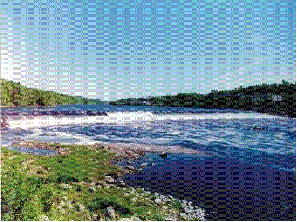
The first dams built in the United States were constructed to provide mechanical
power for industry. For example, the Edwards Dam on the Kennebec River
in Maine (pictured here) was first built in 1837, and by the mid-1840s,
it powered 7 saw mills, a grist mill, and a machine shop. Even at this
time, dams' environmental problems were well understood: local citizens
were concerned that a dam would destroy the Kennebec River's fisheries
and protested the construction of the dam when it was first proposed in
1834.
The dam was built anyway, and as expected, decimated the river's fisheries.
Edwards Dam was removed in 1999 for environmental reasons, and today it
is a symbol for the beginning of the modern era of dam removal. Ten years
later, we can say without question that the removal of Edwards was a success.
In exchange for giving up a tiny amount of hydropower (its power output
could be replaced by two modern wind turbines), we have a restored river.
All ten species of migratory fish that were blocked by the dam can now
be found in the river above where the dam once stood, and the banks teem
with wildlife and native plants. Fishermen and boaters have returned to
the river, and the city of Augusta Maine is reaping the benefits of increased
business and development that focuses on the river as a valuable natural
resource instead of an aging power plant.
 The next wave of dam construction was for hydroelectric power; these dams
were primarily built by private industry. These slides show the Elwha and
Glines Canyon dams on the Elwha River in what is now Olympic National Park
in Washington State, both during construction and as they are today. The
Elwha Dam was built in 1913, and the Glines Canyon Dam was built in 1927.
Neither dam featured fish passage, and their construction cut off six species
of Pacific salmon and steelhead trout from 113 kilometers of habitat, leaving
only 8 kilometers of river open for the fish.
The next wave of dam construction was for hydroelectric power; these dams
were primarily built by private industry. These slides show the Elwha and
Glines Canyon dams on the Elwha River in what is now Olympic National Park
in Washington State, both during construction and as they are today. The
Elwha Dam was built in 1913, and the Glines Canyon Dam was built in 1927.
Neither dam featured fish passage, and their construction cut off six species
of Pacific salmon and steelhead trout from 113 kilometers of habitat, leaving
only 8 kilometers of river open for the fish.
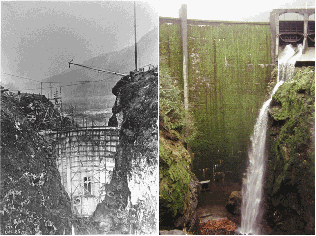 Of course, the fish populations plummeted, depriving the Lower Elwha Klallam
Indian Tribe of their most valuable natural resource. The U.S. government
purchased both dams in 2000, and they are scheduled to be removed starting
in 2011, and it is projected that their removal will result in a nearly
hundredfold increase in fish production, and more than $164 million in
economic benefits associated with recreation, tourism, and sport fishing.
Of course, the fish populations plummeted, depriving the Lower Elwha Klallam
Indian Tribe of their most valuable natural resource. The U.S. government
purchased both dams in 2000, and they are scheduled to be removed starting
in 2011, and it is projected that their removal will result in a nearly
hundredfold increase in fish production, and more than $164 million in
economic benefits associated with recreation, tourism, and sport fishing.
Interestingly, the last private company to operate both of these dams was Daishowa America, a Japanese-owned paper company that used the dams' electricity to power its paper mill in Port Angeles, Washington. Please remember this fact whenever anyone asks you for an additional example of a Japanese dam being removed.
 The final round of dam building in the United States began in earnest during
the 1930s and 1940s, and did not come to a close until the 1980s. While
many dams were still built by private utilities, the Federal government
played a much more significant role in dam building.
The final round of dam building in the United States began in earnest during
the 1930s and 1940s, and did not come to a close until the 1980s. While
many dams were still built by private utilities, the Federal government
played a much more significant role in dam building.
First, the Federal Government used dams to create jobs. These next few
slides show photographs from the Tennessee Valley Authority (TVA), an agency
created to modernize a region - the Southeastern United States - that was
extremely poor even by the standards of the Great Depression. The TVA built
nearly 50 dams. While the region did see some economic growth, the construction
of these dams resulted in significant degradation of aquatic habitat, and
displaced thousands of families from their homes.
Dam construction created jobs for engineers and construction workers -
often in poor rural areas - and provided electricity, which was thought
to be key to rural development.

By the early 1940s, Federal hydropower dams served another purpose: producing electricity needed to make aluminum for airplanes and other weapons. These slides show posters produced by the Bonneville Power Authority (BPA) during World War II. We now know that the electricity from federal dams on the Columbia River and in the Tennessee Valley also served another purpose: enriching uranium that was eventually used to build the first nuclear weapons. So we have another good reason to dislike dams.
Finally, dams were built to deliver water to farmers and cities in the
arid American West. This slide shows Grand Coulee Dam on the Columbia River.
After the Great Depression and the war ended, the pace of U.S. dam construction
accelerated as the U.S. economy grew. There are three federal agencies
that have remained closely involved with dam construction and operation
since that time.
First, the U.S. Army Corps of Engineers (or "Corps") was established
in 1802, and is tasked with maintaining the nation's water resources. It
owns and operates more than 600 dams, and generates about 24% of the hydropower
in the United States (3% of U.S. electricity), making it the largest source
of hydropower in the nation. Most of the Corps' public works projects involve
structures for flood control and navigation.
Second, the U.S. Bureau of Reclamation was established in 1902, and is primarily tasked with providing irrigation water to farmers in the arid Western United States. It owns and operates some of the country's largest dams, including Hoover Dam on the Colorado River and the Grand Coulee Dam on the Columbia.
Finally, the Federal Energy Commission (FERC), which regulates private
hydropower dams, was established in 1920. Since the United States' rivers
belong to the citizens of the United States, any public or private entity
that wishes to build or operate a hydropower dam on a river in the United
States must first obtain a license from FERC. These licenses last for 30
to 50 years, and dictate exactly how the plant will be constructed and
-more important from an environmental perspective - how it will be operated.
Most of my own work involves trying to reform the operation of dams licensed
by FERC.

After the war, the Corps and the Bureau of Reclamation continued to build
dams in earnest, causing massive environmental damage to America's rivers,
especially in the West. These two agencies quickly learned that their job
in assessing the costs and benefits of a project was not that of impartial
analyst, but rather to please politicians by seeking out sites for dams
and keep building them regardless of the costs or social or environmental
impacts. Both of these agencies are famous for "cooking the books"
with biased cost-benefit analyses, numerous errors, and in some cases outright
falsehoods in order to justify construction. FERC does not build dams directly,
but its analysis of proposed private projects was similarly biased towards
construction, and our country's first modern environmental law, the National
Environmental Policy Act, has its roots in a court case involving a fight
over a FERC dam license. Dam building and other water projects were the
currency of pork-barrel politics, and members of Congress used them to
shower their favored constituents with construction contracts, heavily
subsidized water for farmers, and locks and dams that subsidized barge
traffic and encouraged developers to build in natural floodplains. By keeping
their political masters happy, these agencies were rewarded with great
power and independence.
For those of you who are comfortable reading English (I do not believe that the book has been translated into Japanese), I highly recommend Mark Reisner's excellent book "Cadillac Desert: The American West and its Disappearing Water," which tells the story of how these water projects have shaped the American West.
In many ways, the history of the environmental conservation movement in
the United States is very closely tied to attempts to stop dams and dam
building. This slide shows a full-page ad that the Sierra Club famously
took out in the Washington Post and the New York Times to try and halt
a proposed dam in the Grand Canyon. The headline reads: "Should We
Also Flood The Sistine Chapel So Tourists Can Get Nearer the Ceiling?"
 Between 1948 and 1969, environmental NGOs like the Sierra Club and others
successfully defeated attempts to build dams in Glacier National Park (Montana),
Kings Canyon National Park (California), Dinosaur National Monument (Utah
and Colorado), and the Grand Canyon (Arizona). They accomplished this through
direct advocacy, encouraging citizens to write their members of Congress
and other public officials, and working through the media to educate the
public about these awful proposed dams. Despite these efforts, the pace
of dam building only accelerated during this time.
Between 1948 and 1969, environmental NGOs like the Sierra Club and others
successfully defeated attempts to build dams in Glacier National Park (Montana),
Kings Canyon National Park (California), Dinosaur National Monument (Utah
and Colorado), and the Grand Canyon (Arizona). They accomplished this through
direct advocacy, encouraging citizens to write their members of Congress
and other public officials, and working through the media to educate the
public about these awful proposed dams. Despite these efforts, the pace
of dam building only accelerated during this time.
The picture here is of Glen Canyon dam, which sits directly above the Grand
Canyon on the Colorado River. There is an active campaign to remove this
dam, led by the Glen Canyon Institute (www.glencanyon.org).
So how did we change course? How did we stop building dams and instead start making environmental improvements at existing dams and then ultimately removing them altogether? In part, we stopped building dams because many of the best sites (from an engineering or power production standpoint) were already taken. Some of the last dams from the era of large dam building were even built on sites that were geologically unsuitable for dams. This slide shows the Bureau of Reclamation's Teton Dam on the Teton River in Idaho. This $100 million dam was built in 1975 and collapsed in 1976, killing 11 people, 13,000 cows, and is estimated to have caused up to $2 billion in damage.
 In part, years of direct advocacy against wasteful dam building had educated
the public and our leaders about the impacts associated with dams. More
people started to question whether or not new dams were needed, and politicians
started to listen. Shown here is former president Jimmy Carter canoeing
in his home state of Georgia several years before he became the president.
Not long after he was elected President, he published a "hit list"
of 19 wasteful dam projects that he vowed to veto if they were authorized.
In part, years of direct advocacy against wasteful dam building had educated
the public and our leaders about the impacts associated with dams. More
people started to question whether or not new dams were needed, and politicians
started to listen. Shown here is former president Jimmy Carter canoeing
in his home state of Georgia several years before he became the president.
Not long after he was elected President, he published a "hit list"
of 19 wasteful dam projects that he vowed to veto if they were authorized.
We also passed a law - the Wild and Scenic Rivers Act - that gave some of our most special rivers permanent protection from development or dam construction. The river where President Carter is canoeing in this picture is the Chattooga Rivers, one of the first Wild and Scenic Rivers. It is also my favorite river. My organization, American Rivers, was founded right after that law was passed, and our first job was to secure Wild and Scenic protection for as many rivers as we could. We succeeded, and we are still using this law to protect new rivers: last year, Congress passed a law that added 1,800 kilometers of river in Oregon, Idaho, Arizona, Utah, Vermont, and Massachusetts to the National Wild and Scenic Rivers System and protected 130,000 hectares of riverside land.
Other environmental laws have made it more difficult for bad projects to
get built. The National Environmental Policy Act forces agencies to tell
the truth about projects through Environmental Impact Statements. The Endangered
Species Act forbids agencies to take actions that will harm endangered
fish, wildlife, and plants.
If there is one message that I would like to leave with you today, it is this: the most effective changes are not the individual victories in stopping a wasteful dam project or removing an obsolete dam. The changes that have resulted in the most success are the ones that have changed the rules by which decisions are made. As you enter a new political era in Japan, I encourage you to work closely with your leaders and focus your time and attention on strategic changes to the rules of the game of public works construction. I would therefore like to share with you three lessons that we have learned over the years from dealing with dam building and permitting agencies.
Lesson 1: Make them revisit and update dam decisions regularly
If I wanted to build a hydropower dam tomorrow, I would first need to
apply for a license from FERC. That license would tell me in great detail
how to build, maintain, and operate that plant, and it would be illegal
for me to deviate from those license terms. Depending on the amount of
money I invested in building the dam, my license would expire in as few
as 30 or as many as 50 years from now, and the terms will not change unless
I specifically asked for permission to change them. When that license expires,
two things will happen. First, I will be an old man. Second, I will need
to get a new license from FERC if I want to keep generating hydropower.
This may not sound important, but it is. Most of the hydropower dams in the United States were built in a time when environmental laws did not exist and the concept of environmental conservation was seen only as an impediment to "progress." When dam owners are forced to go back to FERC for a new license, there is a great opportunity to examine how a dam is harming the environment and to advocate for license terms that will reduce or remove that harm.
I serve as the Chair of the Hydropower Reform Coalition, a group of 150 NGOs that work on hydropower dams. Together, our group of fishermen, environmentalists, whitewater canoeists, and landowners have become extremely skilled at using FERC's "relicensing" process to force dam owners to restore more natural flows to rivers, protect watershed land, build fish passage, and make other improvements to improve conditions for fish, wildlife, and recreation. We have worked on hundreds of such projects during the past 20 years. Here are just a few highlights:
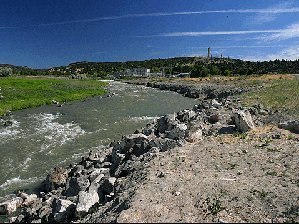
" In the Little Tennessee watershed in Tennessee and North Carolina, our advocacy in a hydropower relicensing resulted in 4,000 hectares of watershed land being permanently conserved, restored flows to two stretches of river that had previously been dried by the dam's bypass, and more than $12 million from the dam owner for environmental conservation and recreation.
" A relicensing on the Lewis River in Washington restored flows to a dry bypass channel, improved (more natural) flows to other river sections, set aside $32 million for recreation, fish, and wildlife improvements, and opened up more than 250 kilometers of salmon habitat.
" On the Bear River in Idaho, a relicensing led to $16 million in habitat improvements for native Trout, the removal of an obsolete 80-year old dam to allow Trout access to habitat in an upstream canyon, and restored flows to a 10-km stretch of river that will improve the river's ecology and improve whitewater recreation. This slide shows the former dam site.
In some cases, where the costs of bringing a dam up to modern standards outweigh the benefits of continued operation, we have even been able to use this process to convince dam owners to remove their dams. Many high-profile completed or planned dam removals are the direct result of this periodic review of FERC dam relicensings, including the Edwards Dam on Maine's Kennebec river, the Elwha and Glines Canyon dams on Washington state's Elwha River, Condit Dam on Washington's White Salmon River, two dams on Maine's Penobscot River, the Dillsboro Dam on North Carolina's Tuckaseegee River, the Powerdale Dam on Oregon's Hood River, the Marmot Dam on Oregon's Sandy River. This video shows the demolition of the Marmot dam and the removal of the cofferdam, where the project engineers simply allowed the river to wash it away.
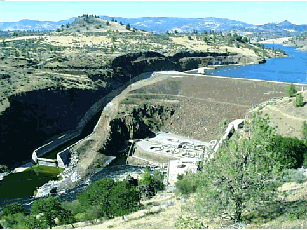 At the end of September, we announced a settlement agreement with PacifiCorp, the owner of four hydroelectric dams on the Klamath River in Oregon and California. If all goes well, the agreement will result in all four of these dams being removed in 2020 to help restore that river's Salmon runs. The dams, built between 1908 and 1962, cut off hundreds of kilometers of once-productive salmon spawning and rearing habitat in the Upper Klamath, which was once the third most productive river for salmon on the West Coast. The dams also create toxic conditions in the reservoirs that threaten the health of fish and people. These four dams produce a small amount of power, which can be replaced using other renewable energy sources and efficiency measures. A study by the California Energy Commission and the Department of the Interior found that removing the dams and replacing their power would save PacifiCorp's customers up to $285 million over 30 years.
At the end of September, we announced a settlement agreement with PacifiCorp, the owner of four hydroelectric dams on the Klamath River in Oregon and California. If all goes well, the agreement will result in all four of these dams being removed in 2020 to help restore that river's Salmon runs. The dams, built between 1908 and 1962, cut off hundreds of kilometers of once-productive salmon spawning and rearing habitat in the Upper Klamath, which was once the third most productive river for salmon on the West Coast. The dams also create toxic conditions in the reservoirs that threaten the health of fish and people. These four dams produce a small amount of power, which can be replaced using other renewable energy sources and efficiency measures. A study by the California Energy Commission and the Department of the Interior found that removing the dams and replacing their power would save PacifiCorp's customers up to $285 million over 30 years.
When the dams are finally removed, it will be the largest single dam removal project in American history, and it happened in a river basin with some of the most hotly-contested water issues in the country, with farmers, commercial fishermen, Native American tribes, and environmental interests all fighting over the river's scarce water. We were able to achieve this dam removal agreement in part by working with all of these groups, and the dam removal agreement is tied to a separate "Klamath River Basin Restoration Agreement" which includes provisions for irrigation water allocations, delivery of water for national wildlife refuges, the rebuilding of fish populations and assistance to impacted communities. While the FERC dam relicensing did not solve these issues, it afforded us an opportunity and gave us a framework in which we could bring all of these groups together and try to resolve the basin's water problems.
Unfortunately, there is no similar requirement for dams that are owned and operated by the federal government. While the Corps and the Bureau of Reclamation have voluntarily brought some of their dams up to date, many are still operated in ways that cause great environmental damage. Without a formal process and a timeline to force this review, it is very difficult to take such a comprehensive look at these dams. As a result, conditions at dams owned by the federal government often much worse than at the private dams that have undergone this dam licensing review. One of my own personal goals is to someday find a way to require a similar periodic review of all federal dams.
Lesson 2: Make them share power with natural resource agencies
All three of the federal agencies I have talked about today are very powerful
and independent, and were even more so at the height of the dam building
era. As you know, it is very difficult to change the culture of an agency,
but you can force an agency to make better decisions by having it share
those decisions with other agencies that have a stronger environmental
protection ethic. I will use FERC as an example. It is governed by an independent
5-member commission, and unlike most other Federal agencies, it does not
answer to the President. It is very protective of this independence. But
a series of changes that forced FERC to give up some of this independence
are responsible for some of our most successful river restoration efforts,
including some of our highest profile dam removals. Before these changes
were made, FERC's relicensing review was little more than a "rubber
stamp" approval. There are several ways in which FERC must now share
its power with others.
First, FERC is now required to give equal consideration to power and non-power values like fish, wildlife, and recreation when making decisions. So it must consider recommendations made by state and federal agencies for protecting fish and wildlife. For example, if a state fisheries agency recommends that FERC require a dam owner to put additional water back into a bypassed stretch of river, FERC must either accept that recommendation and include it in the dam's license or provide a written explanation for why it did not accept the recommendation. In reality, this does not always work, since FERC often rejects recommendations without providing a serious explanation.
Second, Federal agencies now have the power to attach conditions to licenses that FERC cannot reject. If, for example, the U.S. Forest Service asks FERC to require that a given amount of water be put back into a dry river channel, FERC must include that condition in its license. This is much more powerful than a recommendation, as FERC has no discretion to reject or modify the condition. Similarly, if a Federal fisheries agency like the U.S. Fish and Wildlife Service of the National Marine Fisheries Service requests that FERC include a fishway or fish ladder in its license, FERC has no choice but to require the fish ladder. Because these agencies have more interest in environmental protection than FERC does, these conditions can significantly improve environmental quality. Several of the FERC-related dam removals I mentioned earlier - including the Klamath - were cases where the owner decided that it would cheaper to remove the dam than to build required fish passage.
Third, FERC - or any other federal agency that wants to build a dam - cannot issue a license for any dam (new or existing) or build a dam until the state has determined that the dam's operations will meet the state's water quality standards. This gives states veto power over any new dam, and the power to shut down an existing dam as well. States can also attach conditions to licenses that FERC cannot reject. These conditions have resulted in a wide range of environmental improvements, including water temperature and flow improvements as well as fish passage and other protective measures.
Another good idea - although one that we have not tried in the United States yet - is a requirement for independent review of all agency decisions and economic analyses.
Lesson 3: Divert public works money to green projects
 In 1999, American Rivers initiated our dam removal campaign, Rivers Unplugged.
In the ten years since we started, we have seen more than 300 dams removed,
thanks to the efforts of several national NGOs and countless local river
conservation organizations, state and federal natural resource agencies,
and community groups.
In 1999, American Rivers initiated our dam removal campaign, Rivers Unplugged.
In the ten years since we started, we have seen more than 300 dams removed,
thanks to the efforts of several national NGOs and countless local river
conservation organizations, state and federal natural resource agencies,
and community groups.
Like dam construction projects, dam removal projects also require the services of engineers, construction workers, environmental scientists, and others. If a dam construction project can be used to deliver public works spending and jobs, then a river restoration project can, too.
Politicians can help bring jobs and money home while showing off an environmental success story. The Corps has also started to realize this, and now has a growing portfolio of environmental restoration projects, some of which are quite good. This slide shows former U.S. Senator John Warner at the removal of the Embree Dam on Virginia's Rappahannock River. He later described this dam removal as the accomplishment of which he was most proud.
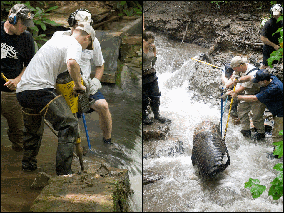 As our River Restoration program has grown, we have been very successful
at finding sources of public money to help pay for these projects. We are
able to do so by demonstrating that dam removal is ultimately less expensive
and better for the environment than spending money to repair old, damaged,
and unsafe dams.
As our River Restoration program has grown, we have been very successful
at finding sources of public money to help pay for these projects. We are
able to do so by demonstrating that dam removal is ultimately less expensive
and better for the environment than spending money to repair old, damaged,
and unsafe dams.
Since 2001, The National Marine Fisheries Service has provided us with $4.5 million for a national grant program to remove dams and other stream barriers. Each year, we administer competitive grants to local organizations for dam removal projectsTo date, this partnership has funded more than 125 river restoration projects nationwide. We are seeking additional funding from this agency that would provide $5.5 million over 3 years for additional restoration projects.
We have also worked with a number of state governments to help them remove
unsafe, obsolete dams. For example, the state of Pennsylvania has provided
us with more than $1.6 million for dam removal projects since 2003. We
have been able to use those funds to attract more than $4 million in other
money and services, and have completed 65 removal projects. An additional
100 projects are underway.
Conclusion
I would like to finish today by briefly sharing with you American Rivers'
vision for 21st century water management. While we are still working on
fixing the problems associated with dams and other massive water infrastructure
projects built in the past, we are trying to present a positive alternative
vision to those types of projects for the future as the United States embarks
on a $1 trillion dollar economic stimulus plan for public works projects.
In our vision, rivers, forests, and floodplains will do what they were
intended to do: work for us naturally, by performing their natural functions.
Clean water is essential to our health, our communities, and our lives. Yet water infrastructure in the United States (drinking water, wastewater and stormwater systems, dams and levees, etc.) is seriously outdated. In addition, we have degraded much of our essential natural "infrastructure" like forests, streams, wetlands, and floodplains. Climate change will aggravate this situation: rising temperatures, increased water demands, extended droughts, and intense storms will strain our water supplies, flood our communities and pollute our waterways.
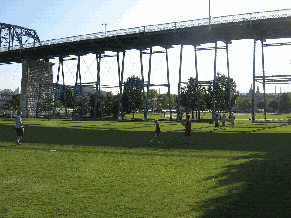 The same bricks-and-concrete approaches we have used for years will not solve today's water challenges. We need to fundamentally transform the way we manage water. A 21st century approach would recognize "green infrastructure" as the core of our water management system. Green infrastructure is the best, most cost-effective, and most flexible way for communities to deal with the impacts of climate change. By green infrastructure, we mean the following:
The same bricks-and-concrete approaches we have used for years will not solve today's water challenges. We need to fundamentally transform the way we manage water. A 21st century approach would recognize "green infrastructure" as the core of our water management system. Green infrastructure is the best, most cost-effective, and most flexible way for communities to deal with the impacts of climate change. By green infrastructure, we mean the following:
" Forests and small streams sustain our clean water supplies by naturally filtering water and removing impurities.
" Landscapes like floodplains and wetlands naturally store flood water and can recharge streams and aquifers.
" Natural water systems in urban settings can help us to capture and use water more wisely, preventing flooding and sewage pollution by managing stormwater naturally.
In sharp contrast to, 21st century green infrastructure solutions are a less expensive and more effective alternative to engineered approaches that rely solely on concrete, pipes, levees, and dams. Green infrastructure preserves and restores natural landscapes, prevents wasteful water use, and works with nature rather than fight against it. Traditional infrastructure is more expensive to build and maintain, damages the environment, and often exacerbates the exact problem it is trying to address. It is often much less expensive and more effective to restore a damaged natural landscape than it is to try and fix aging and ineffective engineered solutions.
Thank you very much for the opportunity to be part of your conference and
to speak to you all today. I look forward to meeting and talking with you
all after today's formal program is complete.
----------------------
American Rivers is the leading conservation organization standing up for healthy rivers so communities can thrive. American Rivers protects and restores America's rivers for the benefit of people, wildlife, and nature. Founded in 1973, American Rivers has more than 65,000 members and supporters, with offices in Washington, DC and throughout the United States.
John Seebach is the Director of American Rivers' Hydropower Reform Initiative. He works to reduce the harm that hydropower dams cause to fish, wildlife, recreation, and the local communities that depend on these resources to survive and thrive. He serves as the Chair of the Hydropower Reform Coalition, an affiliation of more than 150 NGOs that seek to protect and restore rivers impacted by hydropower dams. He has a B.A. from Davidson College, and a M.A. in International Relations and Environmental Dispute Resolution from the University of Kentucky.